
By Mike Markowitz for CoinWeek …..
The coinage of Trebizond supplies an instance, not very rare in numismatics, of a currency of great abundance remaining unknown, or practically unknown, to collectors for several centuries (Wroth, lxxiv).
“…the coinage of the empire of Trebizond, that Cinderella of the late Byzantine coinage (Bendall, 4).”
THE SOUTHERN SHORE of the Black Sea is a narrow strip of fertile land–famed for excellent hazelnuts–between the sea and the rugged Anatolian plateau. The coastal fortress of Trebizond (“Trapezus” to the ancient Greeks and Romans, now Trabzon, Turkey) was the capital of a small, but remarkably durable medieval empire, remembered as the last independent outpost of Byzantine Civilization. We know something about the coinage of this lost empire thanks to diligent research by a handful of scholars and collectors during the past century, notably the great British numismatist Simon Bendall (1937-2019).
The Gabras Dukes
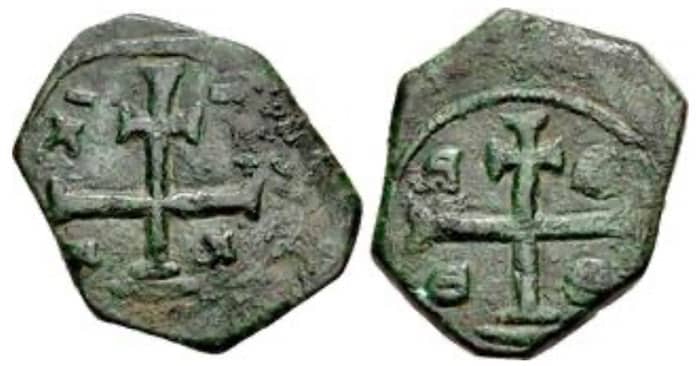
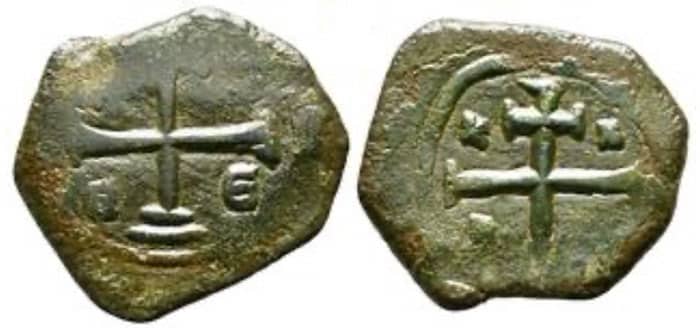
The earliest medieval coins of Trebizond were issued in the 11th and early 12th centuries by semi-independent warlords, local dukes of the Gabras family. Perhaps there was a local shortage of small change due to the region’s distance from Constantinople. We also know the area had rich copper mines. Struck on irregular blanks weighing four to five grams and cut with shears from copper sheets, the coins bear a double-barred “patriarchal cross” on both sides. A coin of Theodore Gabras (ruled 1075-98) from the collection of the late Simon Bendall appeared in a recent CNG auction, realizing an extraordinary $4,500 against an estimate of $200![1] An example from the time of Constantine Gabras (1126-40) brought $288 in a recent European auction.
Andronikos Gidon
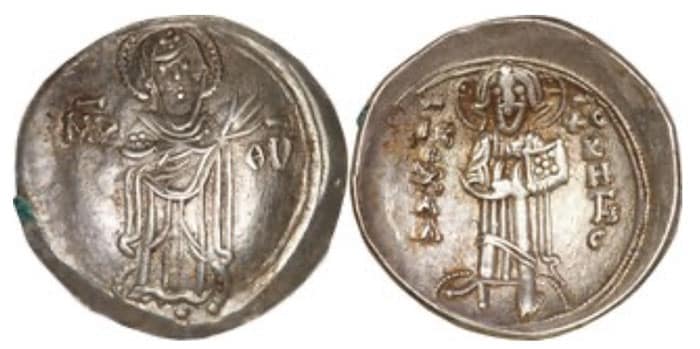
In 1204, Constantinople was treacherously captured and sacked by the Venetian fleet and the knights of the Fourth Crusade, who established a short-lived “Latin” Empire (1204-61). Three Greek successor states emerged, each claiming the Byzantine imperial throne: The Empire of Nicaea in western Anatolia; the Empire of Epirus in the Balkans; and the Empire of Trebizond, established by a branch of the Komnenoi[2], the dynasty established by Emperor Alexios Komnenos[3] (ruled 1081-1118).

The first emperor of Trebizond to strike coins in his own name was Andronikos Gidon, who married a daughter of the empire’s founder, Alexios I, who died in 1222. Coins of Andronikos Gidon were unknown (or incorrectly attributed to Byzantine emperor Andronikos Komnenos) until 1975 when several hoards appeared. The most common type in silver[4] is an anonymous cup-shaped aspron trachy (nominally worth one third of a gold hyperpyron, but probably valued considerably less). The obverse (convex) bears a standing figure of the Virgin with the Greek monogram MP – ΘV, meaning “Mother of God”. The reverse (concave) bears the image of a famous ikon, Christ Chalkites, identified by an inscription on either side.
Another rare type copies the electrum aspron trachy of Byzantine emperor Andronikos I Komnenos (who was torn to pieces by a Constantinople mob in 1185), differing in its metal (pure silver, not electrum alloy) and cruder style[5].
Manuel I

Manuel I (ruled 1238-63) was a younger son of Alexios I, the empire’s founder. He succeeded his brother, Ioannes (John I Axuchos, ruled 1235-38) who died from a fall while playing polo. Trebizond became a vassal of the Mongol Empire (1243), avoiding destruction by paying tribute to the khan. After the Mongols sacked Baghdad in 1258, Trebizond prospered, becoming an important terminus of the Silk Road.
Manuel’s prolific coinage introduced a new denomination, the asper, a flat coin of nearly pure silver weighing about three grams. The obverse bears the name and image of St. Eugenius, a local bishop martyred under the Roman tetrarch Diocletian (ruled 284-305 CE). The reverse shows a standing figure of the emperor being crowned by the hand of God[6]. Manuel’s aspers were widely imitated in Georgia, where crude copies were known as Kirmanouli (“Lord Manuel”), circulating in the region for decades after his death (Lang, 81-87).
George
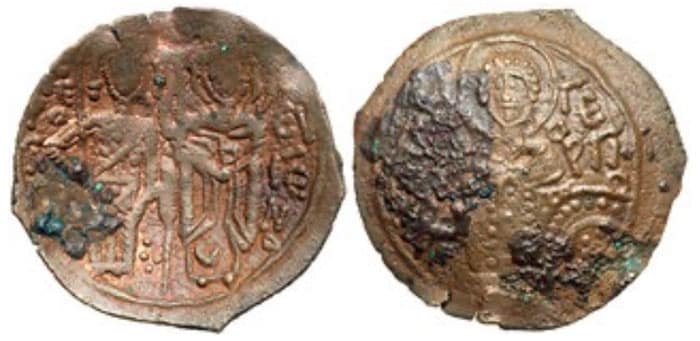
Georgios (or George) was Manuel’s second son, succeeding his elder brother Andronikos II (ruled 1263-66), who died unmarried and without issue; no coins are known from this brief reign. Only rare copper coins[7] are known from George’s 14-year reign, many bearing the image of his namesake, St. George. In 1280, George was deposed in a palace coup under uncertain circumstances; his fate is unknown.
John II
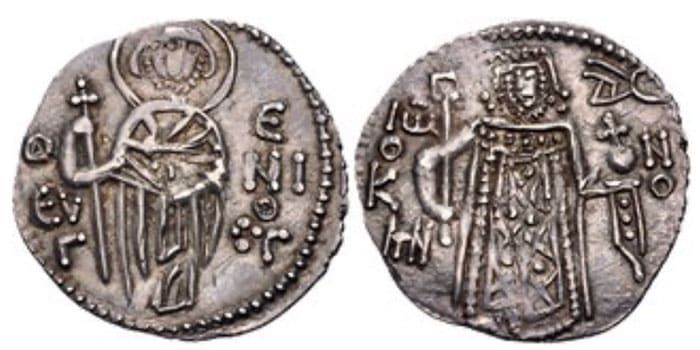
Another son of Manuel I, Ioannes (John II, nicknamed Kaloioannes, “Handsome John”) made a brilliant diplomatic marriage in 1282 to Eudokia, daughter of Byzantine emperor Michael VIII Palaiologos. She bore two sons who became emperors: Alexios II and Michael. To secure this marriage, John II renounced Trebizond’s historic claim to the Byzantine throne. John II ruled for 17 troubled years (1280-97) being briefly deposed by his half-sister Theodora. His silver aspers are relatively common, on some he holds a three-pointed scepter; on others, a long staff (labarum)[8]. During the reign of John II, in 1295, Marco Polo passed through Trebizond on his return to Europe.
Theodora
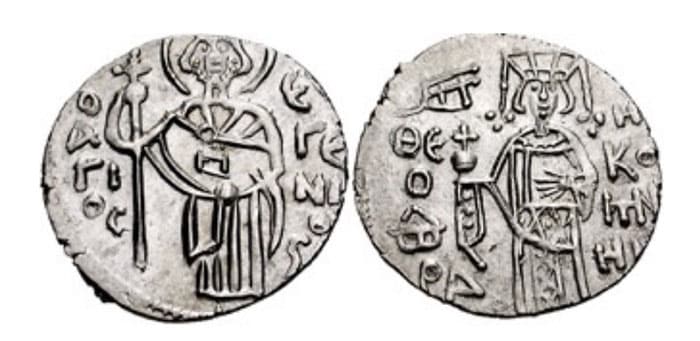
The only empress of Trebizond to issue coins, Theodora was the daughter of Manuel I. Her mother was a Georgian princess. In 1284, Theodora briefly seized the throne from her half-brother, John II. She issued rare aspers that depict her standing, wearing an elaborate Byzantine-style crown[9]. Her fate, after John II returned to power in 1285, is unknown.
Alexios II

Eldest son of John II, Alexios II came to the throne at the age of 14 and ruled for 33 years. He made a major change in the coinage, depicting both himself and St. Eugenius, the empire’s patron saint, on horseback[10]. This became the standard coin design for the rest of the empire’s history. It might reflect the influence of Trebizond’s Mongol overlords or Turkic neighbors, descended from horse nomads who commonly represented their rulers mounted. The silver content of the coins fell by about 15%.
Alexios’ wife, a Georgian princess, bore four sons and two daughters. Two of the sons became emperors, and one daughter, Anna, briefly seized the throne during a chaotic civil war that disrupted the empire in the second quarter of the 14th century.
Andronikos III
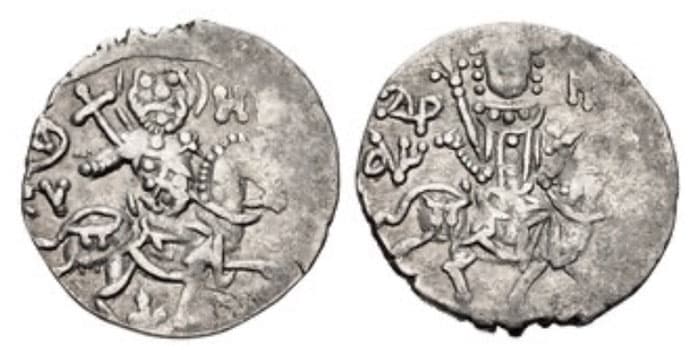
Alexios II died of plague on May 3, 1330, and his eldest son became emperor as Andronikos III. To secure his position, he murdered two of his brothers; a third brother, the future emperor Basil, escaped death only because he was in Constantinople.
Coins from the brief reign of Andronikos III closely follow his father’s types, but the weight declines and the workmanship is poor[11].
Basil
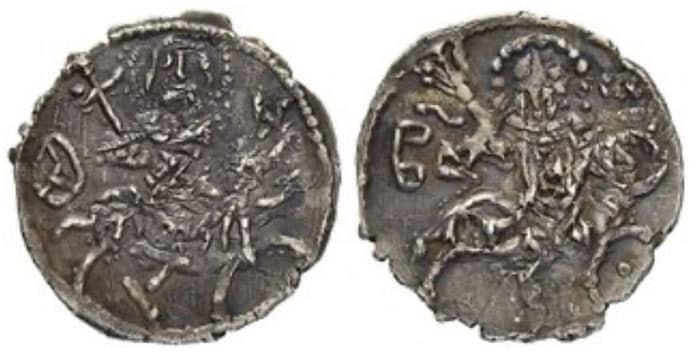
Andronikos III died of plague in January 1332 and his infant son Manuel II was installed as emperor for a few months before Basil returned to seize the throne. Young Manuel II was packed off to a monastery and murdered a few years later. In 1334 Basil married Irene, an illegitimate daughter of Byzantine emperor Andronikos III Palaiologos (legitimate Byzantine princesses were generally reserved as brides for sons of more important kings). Apparently, Basil preferred the company of his mistress (also named Irene – medieval Greeks suffered from a serious shortage of female personal names, an endless source of confusion for historians). On April 6, 1340, Basil was poisoned by his wife, who briefly seized the tottering throne.
Coins of Basil’s eight-year reign are scarce[12], most known examples come from a single hoard that turned up in 1983.
John III
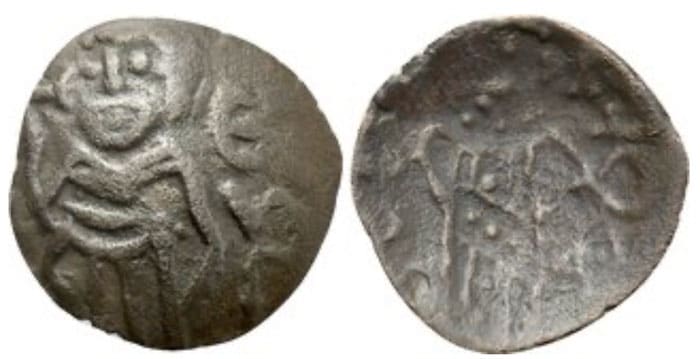
John III was the son of Michael, a Trebizond royal, exiled in Constantinople. Installed with the help of a Byzantine army, the 19-year-old John III soon proved incapable of ruling. His father seized the throne in 1344 and exiled John back to Constantinople. No silver asper of John’s brief reign was known until Simon Bendall identified one in 2004 (Bendall, 57). A few very crude copper coins attributed to John III have appeared recently on the market[13].
Michael

During Michael’s troubled reign of five years, the bubonic plague (the “Black Death”) decimated the population. He faced conflicts internally with factions of nobles and externally with the Turks and the Genoese. Forced to abdicate in 1349, he was exiled to Constantinople. His aspers are rare — a “near VF” example that appeared in a 2014 US auction brought $1,600.
Alexios III
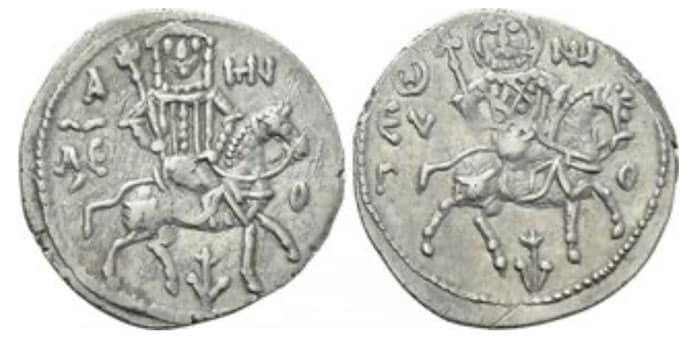
The son of Emperor Basil, Alexios III came to the throne at the age of 11 and ruled for a remarkable 40 years. His wife Theodora was a relative of Byzantine emperor John VI Kantakouzenos (ruled 1347-54.) The most important source for the history of Trebizond is a chronicle written by a member of his court, Michael Panaretos[14].
The coinage of Alexios III was abundant, nearly full weight (a bit less than three grams), and well-struck in good metal[15].
Manuel III
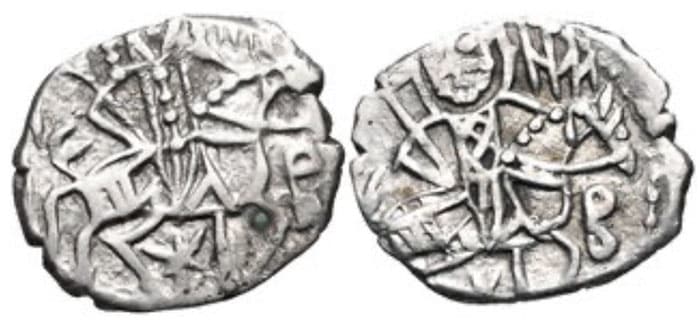
Alexios IV

Born about 1379, Alexios IV ruled for 12 chaotic years. He fought against the Genoese, who increasingly dominated Black Sea regional trade. Trebizond survived an Ottoman attack only because the Turkish assault fleet was driven ashore by storms. He gave his daughter Maria in marriage to the Byzantine emperor John VIII Palaiologos (ruled 1425-48). His son John rose in revolt against Alexios in 1429 and had him murdered.
Silver aspers of this troubled reign often weigh less than a gram[17].
John IV
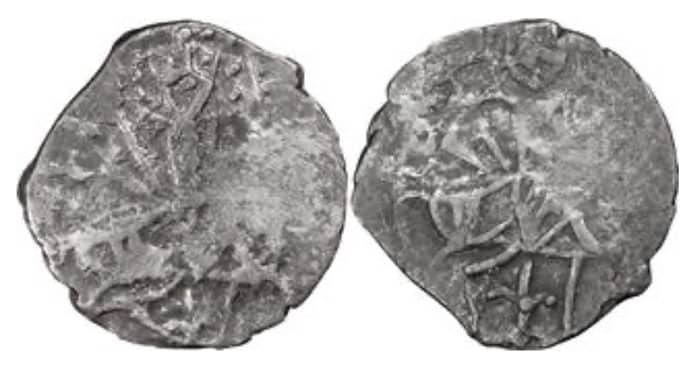
The last emperor of Trebizond to issue coins, John IV ruled from 1429 to 1460. He came to the throne by having his father assassinated – the game of thrones in Trebizond was played by harsh Byzantine rules.
John’s coins are abysmally struck, on blanks too small for the dies. Surviving examples aren’t much to look at. But a case can be made that these sad little pieces are, in fact, the last imperial “Roman” or “Byzantine” coins. John died about 1459 (the date is uncertain), and his brother David ruled briefly until the empire was finally exterminated by the Ottoman Turks in 1461. No coins are known in the name of this last emperor.
Collecting Trebizond
In major ancient coin auctions, only a few coins of Trebizond typically appear at one time, so this is a challenging series to collect. Except for great rarities, the silver aspers generally sell for a few hundred dollars or less. The copper coins are rarely offered but are mostly very inexpensive. In English, the essential reference is a slim booklet: Bendall (2015). Older references like Wroth (1911) are seriously outdated.
* * *
Notes
[1] CNG Auction 115, September 17, 2020, Lot 779. Realized $4,500 USD (estimate $200).
[2] https://en.wikipedia.org/wiki/Komnenos
[3] Often written as “Alexius Comnenus” in Western sources, following Latin spelling.
[4] Heritage Sale 3010, August 12, 2010, Lot 20155. Realized $750 USD (estimate $1,000-$1,500).
[5] NAC Auction 75, November 18, 2013, Lot 891. Realized $2,632 USD (estimate CHF 3,000).
[6] Numismatic Naumann Auction 66, June 3, 2018, Lot 777. Realized $210 USD (estimate €100).
[7] Goldberg Auction 55, October 29, 2009, Lot 635. Realized $480 USD (estimate $150-225).
[8] CNG Electronc Auction 445, June 5, 2019, Lot 545. Realized $240 USD (estimate $100).
[9] CNG Triton VII, January 12, 2004, Lot 1134. Realized $2,600 USD (estimate $1,000).
[10] CNG Triton XIII, January 5, 2010, Lot 1706. Realized $475 USD (estimate $200).
[11] CNG Electronic Auction 472, July 15, 2020, Lot 354. Realized $300 USD (estimate $200).
[12] Sincona Auction 37, May 16, 2017, Lot 530. Realized $431 USD (estimate CHF 350).
[13] Numismatik Naumann Auction 79, July 7, 2019, Lot 829. Realized $365 USD (estimate €80).
[14] https://en.wikipedia.org/wiki/Michael_Panaretos
[15] Numismatik Naumann Auction 71,November 4, 2018, Lot 690. Realized €325 (about $370 USD; estimate €100).
[16] CNG Electronic Auction 372, April 6 2016, Lot 569. Realized $320 USD (estimate: $200).
[17] Nomos obolos 14 Auction, December 15, 2019, Lot 646. Realized CHF 240 (about $244 USD; estimate CHF 75).
References
Bendall, Simon. An Introduction to the Coinage of the Empire of Trebizond. London (2015)
Bendall, Simon. “A Hoard of Early Fourteenth Century Aspers of Trebizond”, Numismatic Chronicle 145. (1985)
Georganteli, Euridice. “Trapezuntine Money in the Balkans, Anatolia and the Black Sea, 13th-15th centuries”, Trebizond and the Black Sea (T. Kyriakides, ed.). Thessaloniki. (2010)
Lang, David. Studies in the Numismatic History of Georgia in Transcaucasia. New York (1955)
Miller, William. Trebizond: The last Greek Empire of the Byzantine Era: 1204–1461. Chicago, (1969 reprint of 1926 edition)
Sear, David. Byzantine Coins and Their Values. London (1987)
Williams, Kelsey J. “A Genealogy of the Grand Komnenoi of Trebizond”, Foundations 2. (2006)
Wroth, Warwick. Catalogue of the Coins of the Vandals, Ostrogoths and Lombards, and of the Empires of Thessalonica, Nicaea and Trebizond in the British Museum. London (1911)
* * *
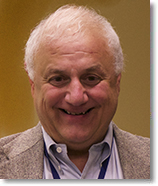 Mike Markowitz is a member of the Ancient Numismatic Society of Washington. He has been a serious collector of ancient coins since 1993. He is a wargame designer, historian, and defense analyst. He has degrees in History from the University of Rochester, New York and Social Ecology from the University of California, Irvine. Born in New York City, he lives in Fairfax, Virginia.
Mike Markowitz is a member of the Ancient Numismatic Society of Washington. He has been a serious collector of ancient coins since 1993. He is a wargame designer, historian, and defense analyst. He has degrees in History from the University of Rochester, New York and Social Ecology from the University of California, Irvine. Born in New York City, he lives in Fairfax, Virginia.




